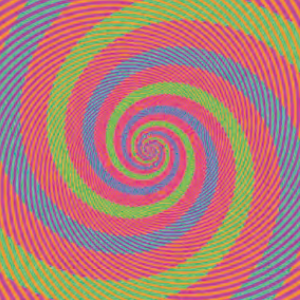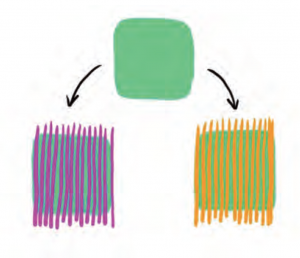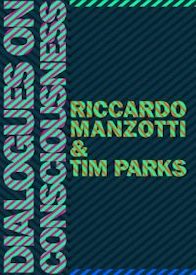
How, Exactly, Does Neuroscience Account for the Way We See Color?
Riccardo Manzotti and Tim Parks Debate the Internalist View of Consciousness
There are no colors out there in the world, Galileo tells us. They only exist in our heads. In the first of our dialogues about the mind, Riccardo Manzotti and I established that by “consciousness” we mean the feeling that accompanies our being alive, the fact that we experience the world rather than simply interacting with it mechanically. We also touched on the problem that traditional science cannot explain this fact and does not include it in its account of reality.
That said, there is a dominant understanding of where consciousness happens: in the brain. This “internalist,” or inside-the-head, approach shares Galileo’s view that color, smell, and sound do not exist in the outside world but only in the brain. “If you could perceive reality as it really is,” says leading neuroscientist David Eagleman, “you would be shocked by its colorless, odorless, tasteless silence.” What Riccardo and I want to do today is ask how, in the neuroscientists’ opinion, we see color. What are the implications of believing that this experience is all inside our heads? And how have scientists reacted to the difficulties they have encountered verifying this theory?
*
Tim Parks: Riccardo, when the internalists talk about conscious experience, they often use the word “qualia,” meaning an elementary sensation, a feeling of something, and one of their favorite examples of this is our seeing color, our experience of color. So how does it come about that we see color?
Riccardo Manzotti: Before answering let’s pay some attention to the language we’re using, since it may determine the way we think about the whole thing. Most people say they see a color or a colored object, a yellow banana, say. So we have subject and object; a person sees a yellow banana. Scientists and philosophers speak of our having an experience, feeling, or qualia. So now we have three things, a subject, an object (the banana maybe), and a feeling, in our heads. I fear both manners of speaking are potentially misleading.
TP: I suppose it’s inevitable that standard views of experience will be built into language use, but can’t we leave this issue for another time?
We have no color outside in the world and yet we can’t find the color in our heads either. So where on earth is it.
RM: I’m not sure we can. The fact is that the subject/object divide, not to mention the addition of a feeling or “percept,” is particularly pertinent when we talk about color.
TP: How so?
RM: Well, as you said, science tells us there’s no color in the world. It occurs only in our brains. But, as we discussed in our first conversation, when scientists look inside the brain to see what’s going on, they find only billions of neurons exchanging electrical impulses and releasing chemical substances. They find what they call correlates of consciousness, not consciousness itself; or in this case, they find correlates of color, but not color itself. There is no yellow banana in the head, just the grey stuff.
TP: I get it. We have no color outside in the world and yet we can’t find the color in our heads either. So where on earth is it? The funny thing is that for most people there is no problem at all. They see a red traffic light and they know to stop. They trust other people to stop. Most of us feel entirely confident about seeing color and even mixing colors. To us color seems to be an external reality, not a subjective delusion.
RM: Absolutely! The unsuspecting layman will assure you that objects simply have colors as attributes—isn’t our banana, for example, very yellow exactly the same way it’s six inches long? Well, unfortunately not, because it could easily be shown that bananas are only yellow under a certain light. Change the light and the banana might look green. But it will always be six inches long.
TP: I had thought color was revealed, as it were, by a refraction, or breaking up of light.
RM: That is the other traditional claim, still widely taught in school, that colors exist in light, or that different colors are different wavelengths of light. And of course the colors of the rainbow immediately come to mind. But that explanation doesn’t work 100 percent either. The same wavelength, for example, will give rise to different colors if the surrounding environment is different. To his credit, Newton himself, who actually introduced the word “spectrum” into the English language to refer to the range of possible colors, eventually dismissed the idea that colors are literally contained in the light. “For the Rays, to speak properly, are not colored. In them there is nothing else than a certain Power and Disposition to stir up a Sensation of this or that Color.” Three hundred years on, what and where colors actually are remains a mystery.
TP: Yet so many books on neuroscience purport to tell us how we perceive color.
RM: Indeed. From the 19th century on scientists have been looking for colors inside the nervous system. First, they worked on the hypothesis that colors were qualities that the retina or the optic nerve introduced into the signals that they then sent to areas further along in the brain. However, nothing satisfactory was ever found, nor is it clear what they imagined they might find. In the 20th century neurophysiologists went deeper and deeper into the brain, tracing the activity of neurons they believed related to the experience of color, until, around 1973, a provisional consensus was reached when the neuroscientist Semir Zeki presented evidence that part of the visual cortex in the occipital lobe at the back of the head, an area called V4, was responsible for color perception, this because damage to that area led to a loss of color perception and color memory. But once again, further research suggested that matters were more complicated, that other areas and neurons could come into play. In short, there is still a great deal of debate on the subject.
You could almost say that the notion of color is useless to color science, unless . . . we bring consciousness back into the picture.
TP: I appreciate that you’ve spent a great deal of time researching the history of science’s dealings with color, but are you telling me that contemporary neuroscience offers no dominant view on the matter?
RM: Well, the current textbook view goes like this. The world is a place where objects reflect light, sunlight being the dominant source and as it were, the default setting as far as the kind of light is concerned. However, each object reflects only a subset of that light. Rays from this subset enter our retina and stimulate a honeycomb of cells, known as cones, because of their conical shape, whose function is to react differently to different portions of the visible spectrum (we remember, of course, that only a small part of the vast electromagnetic spectrum is visible). Most humans—animals are rather different—possess three kinds of cones, referred to as S, M, and L cones, depending on whether they react more vigorously to short, medium, or long-range light wavelengths. The “output” of these cells is first merged together in the retina, then sent via the optical nerve to various cortical areas—including the famous V4. And that’s as much as we know.
TP: Riccardo, you just gave me the whole explanation without ever using the word color.
RM: I know! Oddly, this is a theory of color that does not need the notion of colors. I suppose the reason is that however carefully you follow neural signals from the retina along the optic nerve and across the brain, you don’t actually come across anything like a color, or anything that explains color perception. You could almost say that the notion of color is useless to color science, unless . . .
TP: Unless?
RM: Unless we bring consciousness back in the picture. Colors are something we experience, individually and collectively. But without our experience of color, science would have no reason to suspect its existence. There would just be 50 shades—or more likely 50,000 shades—of electromagnetic waves. That is why even a Nobel Prize-winning biologist like Gerald Edelman tells us that reality is actually colorless; because he takes reality to be what science tells us it is, not what he experiences as an individual.
TP: But the implications of this “official” view are profound. First, it suggests our perceptions are radically separate from the external world, fenced off inside the skull. Second, and as a result, that we all live in error and need the authority of science to tell us what reality is really like. So it gives scientists considerable power.
RM: It’s obvious that for modern science to happen, the object had to be separated from the subject; only an elite of savants could be acquainted with the thing itself. Remember that Galileo, the founder of modern science, was also a Platonist, and Plato was a prominent member of his city’s elite, and the first philosopher to place the object of intellectual enquiry outside of the reach of the everyday man: that is, man is trapped in the cave watching shadows on the wall while reality is outside, beyond his grasp.
TP: I think the thing that most disturbed me when I read Galileo was his exhortation, which Francis Bacon agreed with, that we should do violence to our senses, deliberately go against what they tell us.
Is consciousness a kind of battleground between science and the lay community?
RM: Absolutely. Far la ragione tanta violenza al senso. If science tells you the world has no color, then you must fight against your perception that in fact it is leaping with color.
TP: So, while in our first dialogue, you suggested that consciousness is a challenge for our present scientific model of reality, in that nothing in science predicts the existence of consciousness, now it seems you are going a step further and suggesting that consciousness is a kind of battleground between science and the lay community—with science telling us that conscious experience, color for example, is a brain-based illusion, while for the layman it is reality itself.
RM: Right. You could say that going right back to its origins, science has struggled to keep the lay observer at bay, since his experience—in this case of color—stains the purity of science’s mathematical description of reality (remember that for Plato, and indeed for Newton, a natural law was a divine law). “Our perception of reality,” says Eagleman, “has less to do with what’s happening out there, and more to do with what’s happening inside our brain.” In short, our experience is a kind of hallucination. The world is colorless. The yellowness of your banana is a fantasy. More than that, you . . .
TP: Hold on! I know it’s my fault for raising the question of social implications, but I fear we’re losing focus. Can we try and stay on color and the internalist view of color. Can we sum up? Or did I make a big mistake choosing color as a starting point?
RM: Well, you certainly chose something that brings to the fore the chasm between the neuroscientific, internalist account of consciousness, and our day-to-day experience. Let me try and clinch this with something called Kitaoka’s illusion. Akiyoshi Kitaoka is a biologist and psychologist who has created all kinds of optical “illusions” to demonstrate our supposed fallibility—to catch our brains out, as it were. Check out the spirals here.
 Kitaoka’s illusion.
Kitaoka’s illusion.
Looking at this, we see blue, green, and pink spirals. However, Kitaoka maintains that the two spirals that seem to be green and blue are in fact the same, because the pixels between the thin stripes in each spiral are the same. So the fact that we see one as green and the other as blue is an illusion.
TP: I’m sorry, I really don’t understand.
RM: It’s simpler than it seems. In computer science, engineers have devised a way to produce colors mixing three basic wavelengths, corresponding to red, green, and blue, in dots called pixels. They describe the colors in terms of a so-called RGB triplet, three numbers that specify the quantities of each wavelength in the mix. It is a crude but efficient recipe that allows you to obtain a huge number of colors (on your laptop screen, for example). However, you really can’t predict the color you’ll see from a single RGB triplet any more than you can from a light wavelength, since, in different environments, those triplets will lead to our experiencing different colors, as here with Kitaoka’s spirals. If you check the RGB values for both the green and the blue spirals, you’ll find they are indeed the same (0, 255, 150); what makes the difference is the color of the stripes across the spirals (orange where the spiral is green, magenta where it’s blue).
Science should be accepting the reality of conscious experience and questioning its own obviously imperfect understanding of what constitutes color.
Kitaoka, who’s aiming to demonstrate a distance between appearance and reality, says that since the RGB triplets in the two spirals are the same, we should experience them as the same color.
And if we don’t, it’s because we’re victims of an illusion. Let me draw you a cruder version on the iPad [below].
 Manzotti explains Kitaoka’s illusion.
Manzotti explains Kitaoka’s illusion.
TP: Fascinating.
RM: But hardly instructive! Anyone can see that there are blue spirals and green spirals. And everyone does see that, or at least everyone with what we call normal sight. Rather than insisting that the same pixels should always appear as the same color and talking about an appearance/reality gap, what science should be doing is accepting the reality of conscious experience and questioning its own obviously imperfect understanding of what constitutes color.
TP: I recall now how the neuroscientist Christof Koch claims that our experience of color is “a con job.” David Eagleman talks about vision being the result of “fancy editing tricks.” The philosopher Eric Schwitzgebel accuses us of being “ignorant and prone to error” about everything we see. A moral nuance is smuggled into the debate, as if there were something shabby and lazy in the way we see the world. It feels like we’re being blamed, or condescended to, for not perceiving things as science thinks we ought to.
RM: Exactly. Kitaoka’s illusion—and there are many others like it—becomes a flash point where the assertions of science in the Galileo tradition clash with the validity of our conscious perception.
TP: So the question is, who is in denial? Science with an inadequate understanding of color, or the ordinary individual with his or her experience of it?
RM: Right, so maybe what we need to do is to get beyond the idea that consciousness is a “representation” of the world at all. Maybe it is simply reality. Maybe, as I hinted at the beginning, we have to do away with that subject/object distinction which lies behind this whole discussion.
TP: Maybe we do, but not today. I had promised that we would look at how internalists have responded to their failure, at least so far, to show how the brain produces consciousness, how that colorless world is colored in. But I now see that was a bridge too far. We’ll leave it to the next dialogue, when the question will be this: How are internalists defending or proposing to defend a position that you obviously reckon is indefensible?
———————————————

Excerpted from Dialogues on Consciousness by Riccardo Manzotti and Tim Parks. Reprinted with the permission of publisher, OR Books. © 2019 Riccardo Manzotti and Tim Parks.
Riccardo Manzotti and Tim Parks
Riccardo Manzotti is a philosopher, psychologist, and robotics engineer who has written more than 50 scientific papers and several books, among them The Spread Mind: Why Consciousness and the World Are One. A former Fulbright Visiting Scholar at MIT, he is now visiting professor at UAEU University (Emirates). Tim Parks, novelist, essayist and translator, is the author of 19 works of fiction, including Europa, shortlisted for the Booker. He is a regular contributor to both The New York Review of Books and The London Review of Books. He lives in Italy, where he teaches literature and translation studies at IULM in Milan.












